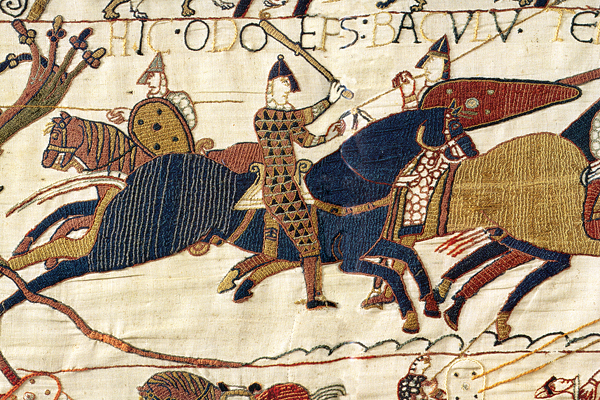
Return to the Battle of Hastings

"The women of the English people are very skilled in needlework and weaving gold thread, and the men are outstanding in craftsmanship of all kinds."
William of Poitiers, Gesta Guillelmi
Embroidered on linen with colored woolen thread, the Bayeux Tapestry is a unique record of the Battle of Hastings and the costumes, arms, and manners of the time. Almost two hundred and thirty-one feet long and twenty inches wide, with decorative borders and a continuous description in Latin, the Tapestry presents seventy-two scenes. The final section is missing but possibly depicted the Norman occupation of England and the coronation of William on Christmas Day, 1066.
The Tapestry may have been commissioned by William's half-brother Odo, Bishop of Bayeux. He is prominently portrayed, and several figures known to have been his retainers are presented. If it was made for him, perhaps to adorn a palace hall, it must have been before his imprisonment in 1082 or more likely for Bayeux Cathedral, before its dedication in 1077. Odo became Earl of Kent at the Conquest, and the Tapestry may have been executed at Canterbury. Certainly, the design and embroidery suggest English workmanship, as does the Anglo-Saxon orthography in the inscription.
Even though the narrative seems to have derived some of its information from the Gesta Guillelmi of William of Poitiers, there are differences between the two accounts. The Tapestry emphasizes the role of Odo, and Harold's oath to Duke William, which is its central theme, is placed at Bayeux. Too, the English are portrayed more sympathetically: Harold is not denigrated but shown to die a heroic death, and a mother and child flee from a house set afire by the Normans.
The Tapestry first is recorded in the fifteenth century as part of the inventory of Bayeux Cathedral, where, every year, it was hung in the nave. During the French Revolution, it was to have been used as a wagon cover before being rescued; later, it was prevented from being cut up to decorate a carnival float dedicated to the goddess of reason. The Tapestry was restored in the nineteenth century, though the original colors were not always fortuitously duplicated.
Yet, in spite of such vagaries and mishaps, this fragile strip of linen and wool has survived fire and upheaval for more than nine hundred years and, together with the account of William of Poitiers, is a primary source for the Battle of Hastings.
In the detail above, Odo is identified by the inscription above him: HIC ODO EPS [EPISCOPUS] BACULUM TENENS CONFORTAT PUEROS ("Here Bishop Odo, holding a staff, encourages the young men").
Wace recounts the event in the Roman de Rou, a twelfth-century history of the dukes of Normandy.
"Then Odo, the good priest, the bishop of Bayeux, galloped up, and said to them, 'Stand fast! stand fast! be quiet and move not! fear nothing, for if God please, we shall conquer yet.' So they took courage, and rested where they were; and Odo returned galloping back to where the battle was most fierce, and was of great service on that day. He had put a hauberk on, over a white aube; wide in the body, with the sleeve tight; and sat on a white horse, so that all might recognise him. In his hand he held a mace, and wherever he saw most need, he led up and stationed the knights, and often urged them on to assault and strike the enemy."
Odo no doubt was prepared to enforce his exhortations with an argumentum ad baculinum, an appeal to force that here takes the form of a baston, a wooden bludgeon or cudgel that was the precursor to the iron mace of the Middle Ages. The club (which also was his staff of office, cf. "baton") presumably is used in lieu of a sword because of an edict of the Council of Rheims in 1049 prohibiting the clergy from bearing arms.
Reference: The History of the Norman People: Wace's Roman de Rou (2004) translated by Glyn S. Burgess and Elisabeth Van Houts.